In my recent post about restaurant Vinodol in Zagreb, I got to try veal “under the bell” – teletina ispod peke or pod pekom in Croatian. Dating from Neolithic times, the peka is a large, vaguely bell-shaped ceramic or iron dish used for baking on an open hearth. Typically, a copious meal of protein (veal, lamb, octopus) and potatoes, sometimes with other vegetables, is laid in a shallow pan on the warm floor of the hearth, covered with the peka, then heated and topped with embers kept in place by a ring attached to (or molded onto) the peka. The result is tender meat with super-soft potatoes and concentrated flavors.
Croatia isn’t the only country to cook with a peka and an open hearth. The technique is also used in Slovenia, Serbia, Montenegro, Bosnia, southern Hungary, Romania, Bulgaria, and even parts of Italy. In Croatia, the ceramic peka was traditionally made by local potters either on a potter’s wheel or with a mold, depending on the region. Iron peka, called sač, spread to the Balkans via the Ottoman Empire.
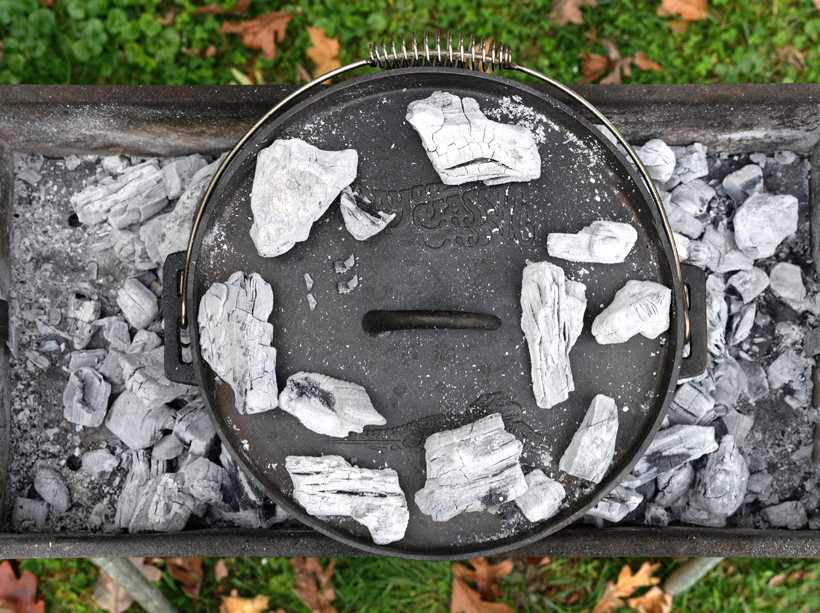
“Does he really think,” some of you might groan, “that we’re gonna build a hearth in our kitchen or our backyard, and ask the local potter or blacksmith to make a giant bell-shaped lid???” Fear not, for I have a much simpler solution. It turns out that most of the western world has at its disposal a piece of kitchen cookware that’s almost exactly equivalent to the Croatian peka: the camping cast-iron Dutch oven. It can resist very high temperatures, you can put embers on the lid, and, best of all, it fits perfectly in most charcoal grills! If the typical grill doesn’t hold heat as well as a brick or stone hearth, you can easily compensate by preparing a supply of hot embers that will last for the entire duration of the cooking.
Some peka recipes are very evasive when it comes to the cooking (e.g., “the timing simply can’t be explained”), which is just B.S., even if, as for almost everything in life, practice makes perfect. Others choose to steer clear from white meats, which dry more easily, and large cuts, which make the doneness harder to control. That’s sad because veal is a very popular option in Croatia and a whole roast adds to the drama of the final presentation.

The challenge is in cooking all the ingredients blind. Coal fires don’t come with control knobs and you can’t open the pot too often, but you need to get the meat to the right doneness, and you don’t want to burn the potatoes and other vegetables. You’ll see below that with a few precise control points throughout the cooking, you can make a great veal roast under the Dutch-Croatian bell. Even more so if you always use the same ingredient proportions, Dutch oven, grill, and charcoal.
Cooking times may depend on your setup, and mine are fairly short (compared to other recipes) because I make the pot as hot as possible – why bother with all this setup if you can reach the same temperatures in your kitchen oven? For this reason, you’ll want to rely on the internal temperature of the meat. You could use a temperature probe with a wire (as long as you can still close the Dutch oven properly), I just don’t own one so I use my digital thermometer. Ideally, I’d try the recipe a couple more times to double-check my timings, but the overall approach is sound. To bring you the perfect peka recipe, I’ve now consumed over 10 kilos (24 pounds) of veal, with the help of a small handful of devoted family members!
So what cut of veal should you use? Chuck and neck roasts are frequent picks, and there’s satisfaction to be drawn from turning cheap cuts like these into delicious meals. Cooked properly, their meat can be quite tender and flavorful. Other recipes recommend thigh, shoulder, or knee. I’d be worried that the thigh is too lean, but the other cuts sound like reasonable choices. And looking at my pictures of meat stalls at Zagreb’s Dolac Market, I see that the butchers who sell veal offer cuts from the neck, shoulder blade, rump, and ribs. Now, a rib roast, though manyfold more expensive than everything else (at least where I live), can be an amazing meal – tender, juicy, flavorful, with just the right amount of fat – but it does require less cooking time. So I’ve decided to give you two versions of my recipe: one for a chuck roast, and one for a rib roast. Both make for a fantastic dish!
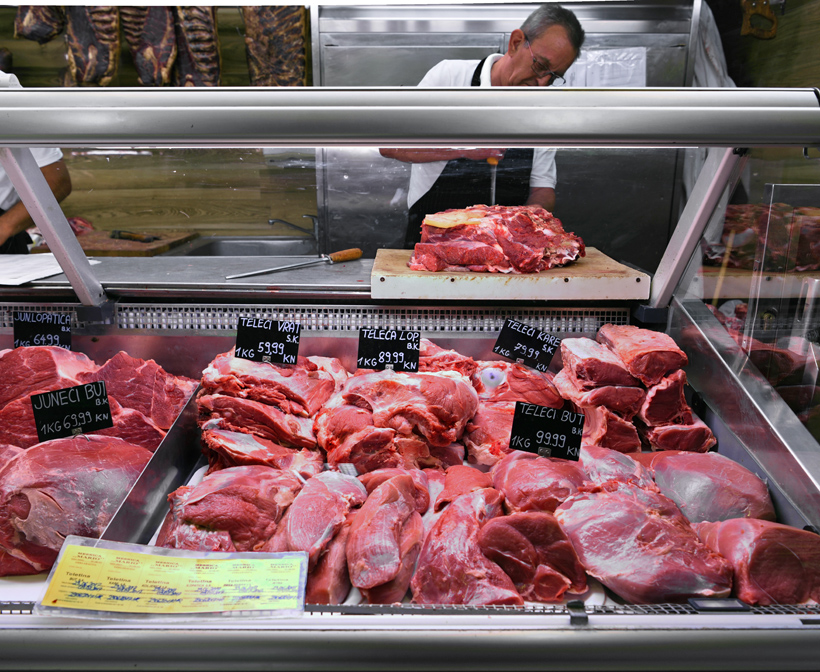
As for the vegetables, potatoes are a must. Restaurant Vinodol in Zagreb adds tomatoes and onions, and restaurant Dubrovnik in New Rochelle, New York includes carrots, red peppers, and onions. Here I’m only adding spring onions (which can be replaced with shallots). Whatever you decide, keep your vegetables whole or in large chunks and add them towards the end of the cooking so they don’t turn into a mush.

Finally, there’s the question of the sauce. Teletina ispod peke is normally served with the cooking liquid, made of water, wine, and meat jus – if there’s nothing left in the pot when the cooking is done, just add a little bit of water or stock. I’ve chosen to make a separate sauce with fresh morels and cream (which partly explains why I didn’t want to use too many vegetables in addition to potatoes). If morels are in season, I urge you to give this sauce a try, as the mushrooms’ earthiness complements the meaty flavors beautifully.

Morel sauce
Yields about 525 g (7 servings)
225 g fresh morels
40 g butter
50 g peeled shallots, fine brunoise
10 g Dijon mustard
salt
black pepper, ground
150 g white or orange wine
150 g veal stock
7.5 g morel powder (ground dried morels)
250 g heavy cream
2.5 g corn starch
15 g cold water
- Rinse the morels under cold water and dry them on paper towels. Cut the larger ones into halves or quarters, lengthwise.
- Melt the butter in a saucepan over medium heat. Add the shallots and cook until golden brown, stirring regularly. Stir in the mustard, then add the morels and season with salt and pepper. Sauté for about 5 minutes until the mushrooms are tender, still stirring once in a while.
- Add the wine and simmer until reduced by half. Add the veal stock and morel powder and reduce by half again.
- Stir in the cream, bring the sauce just back to a boil, then simmer for 10 minutes.
- Mix the corn starch and water in a small bowl, then whisk into the sauce, which will thicken at once. Rectify the salt and pepper seasoning.
- You should have about 525 g sauce at this point. If you have more, keep reducing it over medium heat. If you have less, stir in some more veal stock or water.
- Transfer to a bowl, let cool, and reserve. The sauce may be kept in the refrigerator for up to one day, and its flavor will intensify.
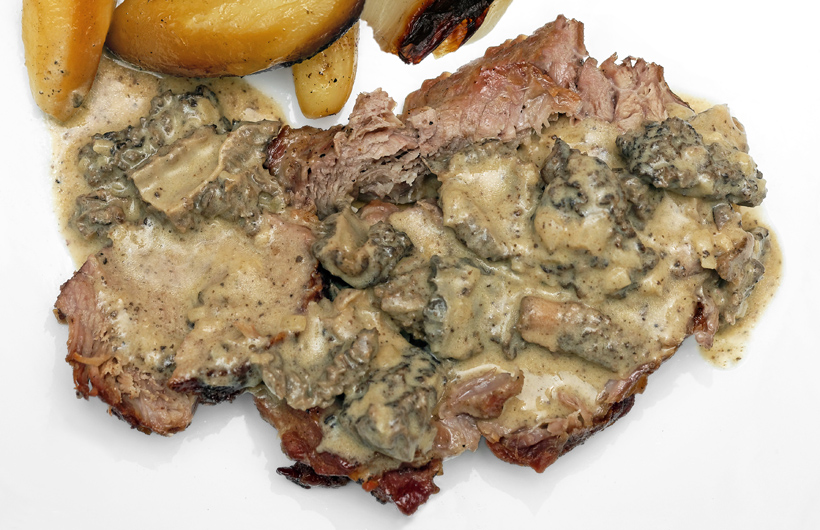
Veal Under the Bell preparation
Yields about 7 servings
about 2000 g veal chuck roast (boneless) or 2000 g boned rack of veal (6 chops, 2800 g with bone)
about 22 g salt (see below)
50 g olive oil
200 g white wine
400 g water
1350 g peeled fingerling potatoes (about 1850 g skin-on)
black pepper
350 g peeled large spring onions or shallots (7 pieces of the same size)
thyme leaves (from 3-4 sprigs)
- Take the meat out of the refrigerator, and leave at room temperature for about 2 hours.
- Fill a 30 cm x 60 cm rectangular grill (or a 48 cm diameter round grill) with charcoal. Use lump charcoal, not briquettes. (Not that you can’t use briquettes, but all the timings below will be off. Briquettes don’t get as hot, and regardless of what I often read, I’m not even sure they burn as long.)
- Light the charcoal and heat. Reorganize the coals and blow with bellows regularly to make the embers evenly hot and very hot. When there are no more flames and almost all the coals are white, the fire is ready. It usually takes about 1 hour from the start.
- Meanwhile, measure 1% of the meat’s weight in salt. Season the veal on all sides (including inside if the meat isn’t just one monolithic piece). Tie into a roast with butchers’ twine, keeping the fat outside whenever possible.
- On a stove top, heat a 30 cm diameter, 13 cm tall cast iron dutch oven over medium-high heat. Sauté the meat in half of the olive oil for 15 minutes, turning it regularly to brown it on all sides.
- Add the wine and reduce for a couple minutes. Cover with the lid, remove from the heat, and reserve until the fire is ready.
- Proceed to either one of the recipes below, depending on which cut of meat you’re using.

For Veal Chuck Under the Bell:
- Make room for the Dutch oven in the center your grill. Place the pot there, and collect the remaining coals around it, blowing on the embers with bellows. Transfer a few coals onto the pot lid, and cook for 15 minutes.
- Remove the coals from the lid, dust off the ash, and open the Dutch oven. The internal temperature of the meat should be around 49 C / 120 F. If the temperature is lower, close and cook another 5 minutes.
- Add half of the water and turn the roast 90 degrees. Arrange the potatoes around the meat and season with salt (1.5% of the weight of the potatoes) and black pepper. Pour the remaining olive oil over the potatoes. The Dutch oven should be pretty packed now – it shouldn’t look like a little bit of food in the center of a big pot. Replace the lid and the embers on top, and collect the remaining coals around the pot, blowing on them with bellows again, then cook for 20 minutes.
- Remove the coals from the lid, dust off the ash, and open the Dutch oven. The internal temperature of the meat should be 63-65 C / 145-150 F. If the temperature is lower, close and cook another 5 minutes.
- Turn the roast 90 degrees and gently stir the potatoes so that they don’t burn on the bottom and sides of the pot. Add the spring onions or shallots, thyme leaves, and the remaining water. Once again, replace the lid and the embers on top, and collect the remaining coals around the pot, blowing on them with bellows, then cook for 20 minutes.
- Remove the coals from the lid, dust off the ash, and open the Dutch oven. The internal temperature of the meat should be around 82 C / 180 F. If the temperature is lower, close and cook another 5 minutes.
- Replace the lid, remove the Dutch oven from the fire, and proceed with the assembly steps.



Veal Rack Under the Bell
- Before transferring the pot to the grill, add half of the water, arrange the potatoes around the meat, season with salt (1.5% of the weight of the potatoes) and black pepper, and drizzle with the remaining olive oil. The Dutch oven should be pretty packed – it shouldn’t look like a little bit of food in the center of a big pot. Replace the lid.
- Make room for the Dutch oven in the center your grill. Place the pot there, and collect the remaining coals around it, blowing on the embers with bellows. Transfer a few coals onto the pot lid, and cook for 20 minutes.
- Remove the coals from the lid, dust off the ash, and open the Dutch oven. The internal temperature of the meat should be around 38 C / 100 F or slightly over. If the temperature is lower, close and cook another 5 minutes.
- Turn the roast 180 degrees, and gently stir the potatoes so that they don’t burn on the bottom and sides of the pot. Add the spring onions or shallots, thyme leaves, and the remaining water. Once again, replace the lid and the embers on top, and collect the remaining coals around the pot, blowing on them with bellows, then cook for 20 minutes.
- Remove the coals from the lid, dust off the ash, and open the Dutch oven. The internal temperature of the meat should be 57-60 C / 135-140 F. If the temperature is lower, close and cook another 5 minutes.
- Replace the lid, remove the Dutch oven from the fire, and proceed with the assembly steps.
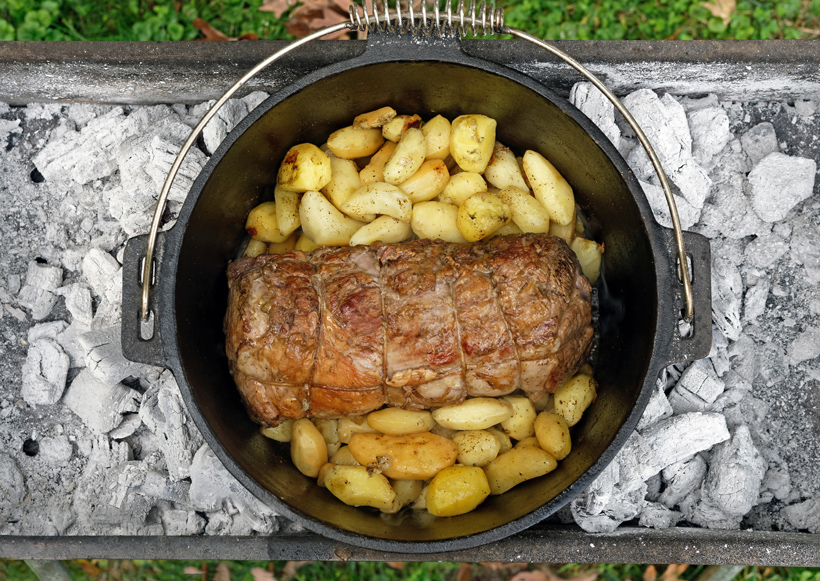
Assembly
Yields about 7 servings
Veal Under the Bell
morel sauce
thyme leaves
- Transfer the veal roast to a cutting board, and let rest for a few minutes.
- Transfer the potatoes and spring onions or shallots to a bowl.
- Reheat the morel sauce in a sauce pan over medium-low heat.
- Cut the meat into 0.5 cm thick slices. Arrange a few slices on each plate and cover with morel sauce. Garnish with vegetables on the side and sprinkle with thyme leaves.
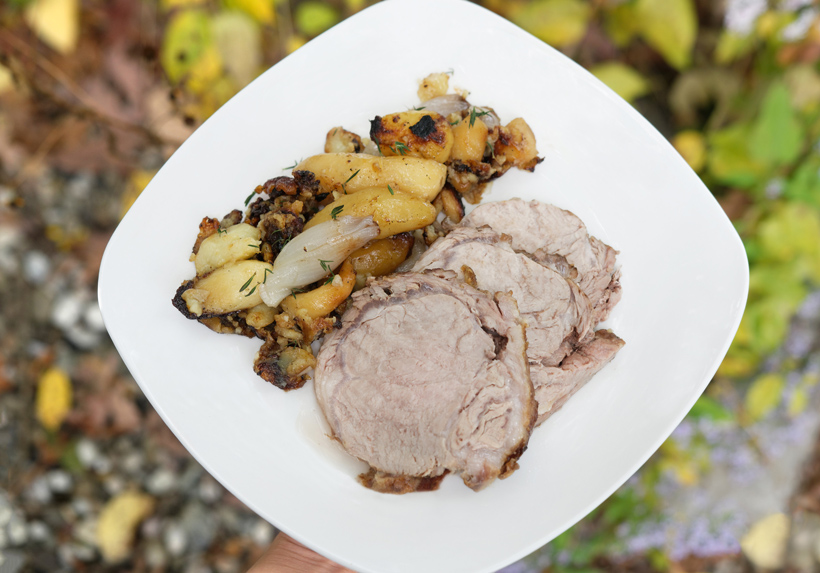

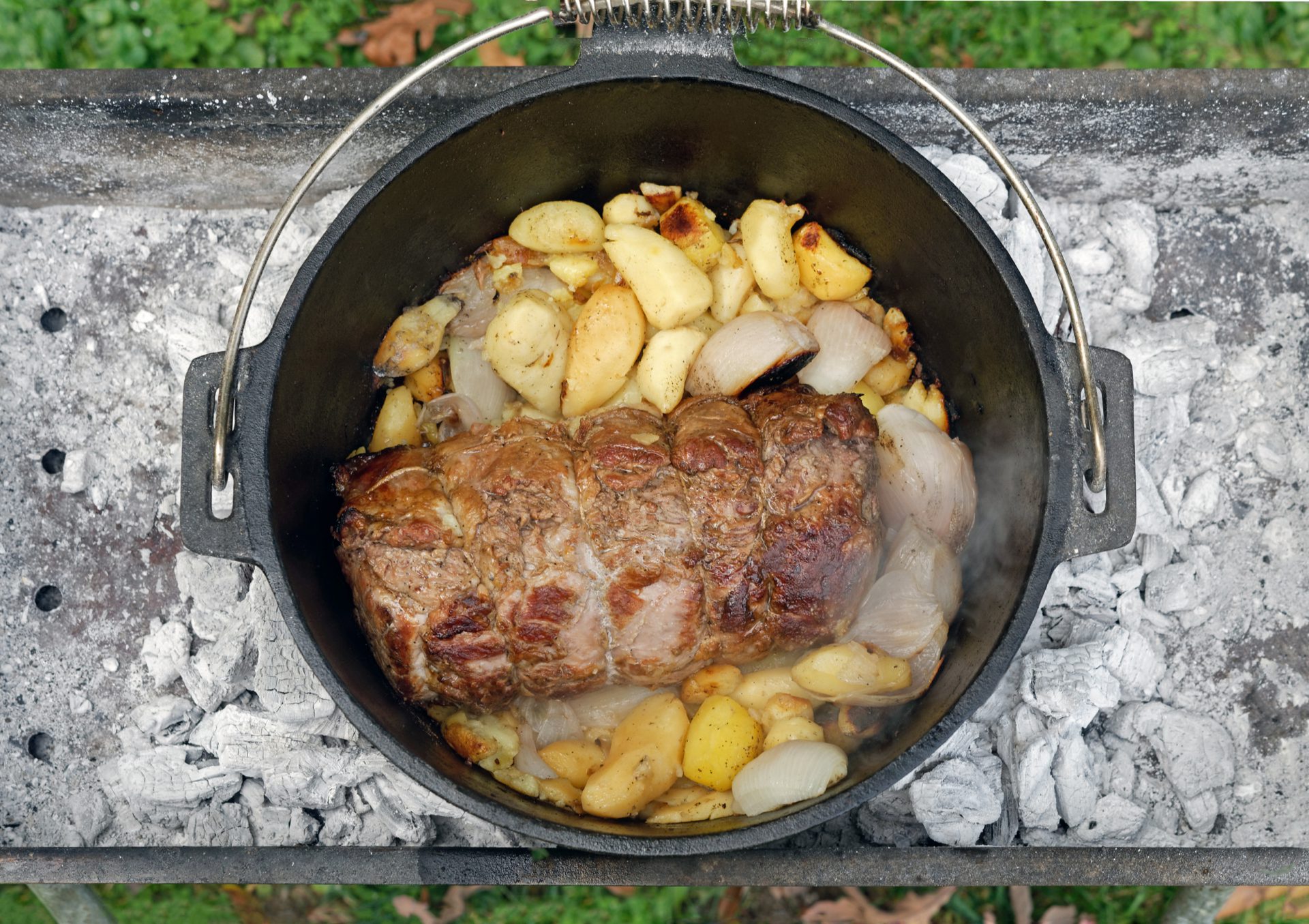


1 comment
Memories of a year in Zagreb.